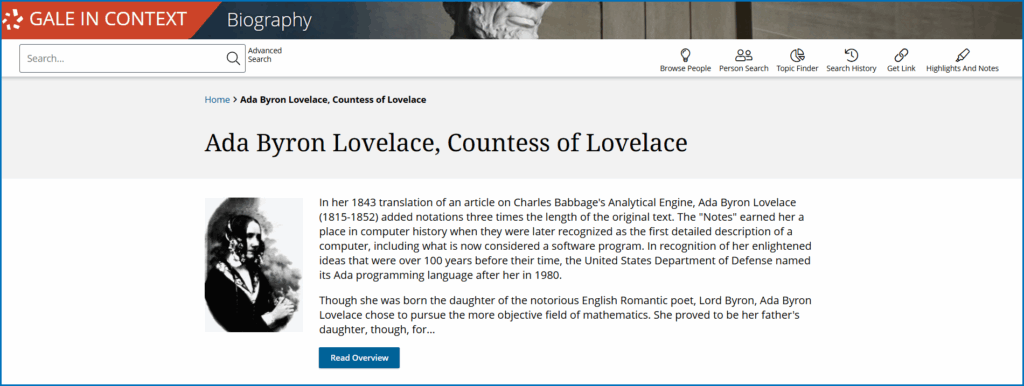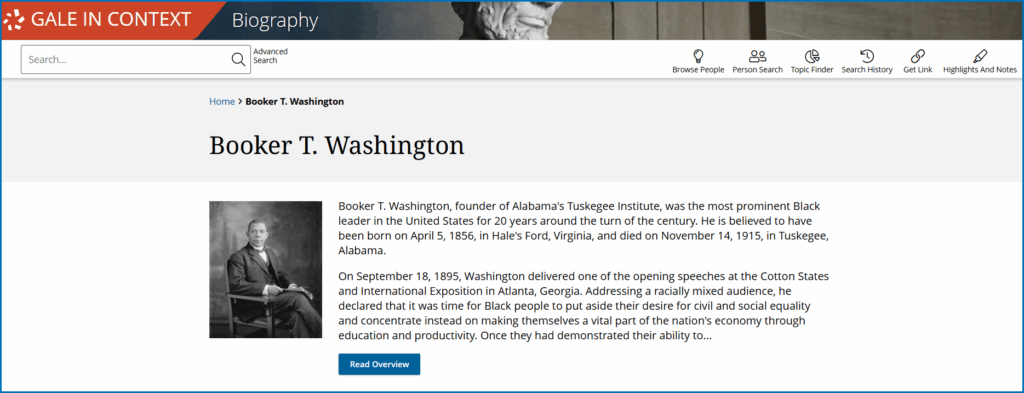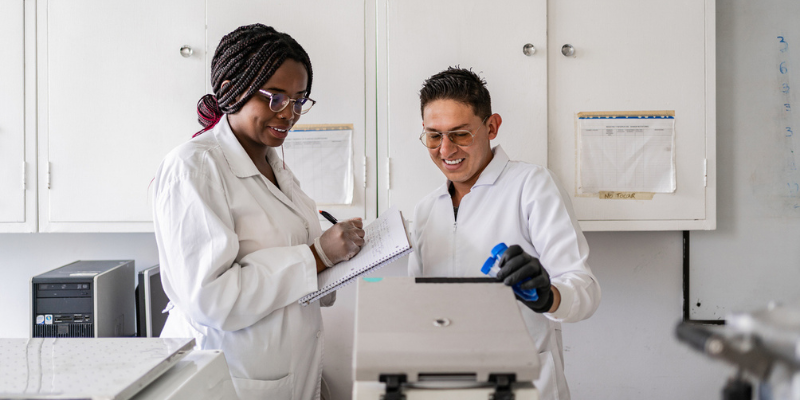| By Gale Staff |
Observed every November 10, UNESCO established World Science Day in 2001 to celebrate the spirit of scientific progress and accomplishment. World Science Day can inspire lesson plans and encourage educators and students to take a closer look at the impact of science in our everyday lives.
For educators, World Science Day presents an opportunity to explore the contributions of accomplished scientific pioneers. Gale In Context: Biography offers in-depth biographies of hundreds of scientists and can serve as a helpful resource for lesson planning and student research. Through these biographies, students can learn about scientific accomplishments and understand how science has shaped their lives.
Our reader-friendly biographies come with a curated set of reference entries, magazine articles, and news stories, allowing students to thoroughly research the subject’s story. Additionally, Gale’s accessibility features include text-to-speech and adjustable font size to accommodate different reading levels and engage all learners, promoting broad participation.
To help you plan an engaging lesson for World Science Day, let’s explore the contributions of five notable scientists.
Stephen Hawking
Renowned theoretical physicist Stephen Hawking (1942–2018) made groundbreaking contributions to science, focusing his research on the origins of the universe and black holes. Hawking’s 1998 book, A Brief History of Time: From the Big Bang to Black Holes, introduced everyday readers to cosmology—both the history of the field and Hawking’s own contributions. He researched the relationship between space, time, and quantum mechanics, and developed a set of laws about black hole thermodynamics.
Over the course of his career, Hawking’s contributions garnered him many awards. In 2006, he earned the Royal Society’s Copley Medal for his contributions to theoretical physics and cosmology. In 2009, President Barack Obama awarded Hawking the Presidential Medal of Freedom, and in 2012, Hawking won the prestigious Fundamental Physics Prize.
At the age of 21, Hawking was diagnosed with Lou Gehrig’s disease, also known as ALS—a devastating disease with a life expectancy of two to five years from the time of diagnosis. Nonetheless, Hawking lived and worked with the disease for an astounding 50 years. He relied on assistive technology that allowed him to write and speak through a voice synthesizer. Thanks to this technology, Hawking contributed to the fields of theoretical physics, astronomy, and cosmology until his death in 2018.
→ Learn more about ALS, and the remarkable life of baseball legend Lou Gehrig
Ada Lovelace
Considered the world’s first computer programmer, Ada Lovelace (1815–52) made significant contributions to mathematics and computer science that remain impactful today. The daughter of famed British poet Lord Byron, Lovelace opted to study mathematics. In 1843, she translated and annotated an article about Charles Babbage’s Analytical Engine, with annotations that far exceeded the length of the original article. Ultimately, Lovelace’s detailed and insightful notations established her as a leading figure in mathematics and computer science and have become regarded as the first description of a computer and a software program.

In Lovelace’s era, few women studied mathematics, making her contributions even more remarkable. Because Lovelace died at the age of 36, much of her recognition arrived posthumously. In 1953, B.V. Bowdon published her annotations, helping transmit her research to a new audience. In the 1970s, the U.S. Department of Defense named its computer programming language Ada, after Lovelace; it remains in use today. Today, Ada Lovelace Day, celebrated on the second Tuesday in October, honors her contributions to mathematics and computer science as well as the achievements of all women working in STEM.
→ Discover other female inventors to incorporate into World Science Day curriculum
George Washington Carver
George Washington Carver (1864–1943) was an agricultural chemist, botanist, and inventor. After the dissolution of slavery, Carver sought higher education. Although the path was not easy, he became the first black student at Simpson College and later, Iowa State University, where he earned a bachelor’s and master’s degree.
Booker T. Washington hired Carver to run the Tuskegee Institute’s agriculture department. He later oversaw the Tuskegee Experiment Station, where his creativity flourished. Carver’s innovative experiments revolutionized Southern agriculture by recommending crops beyond cotton, such as peanuts. Over the course of his career, Carver developed nearly 300 peanut byproducts, ranging from candy and ice cream flavoring to ink and dyes.

Carver’s impact was far-reaching. He didn’t just help diversify Southern agriculture, he also worked to educate Southern farmers—both black and white—by making scientific and technical writings easy to understand. With his Jesup Wagon, a mobile classroom, Carver traveled to farmers in the early 1900s, educating them about agriculture.
Today, Carver remains a symbol of the value of black ability and achievement. The George Washington Carver National Monument in his birthplace of Diamond, Missouri, pays tribute to Carver and his accomplishments.
Mae Jemison
Mae Jemison (b. 1956) is an engineer, physician, and NASA’s first female African American astronaut. After earning a degree in chemical engineering and African and Afro-American studies from Stanford University, Jemison continued her education by earning a medical degree from Cornell University. She then worked as a Peace Corps medical officer in Sierra Leone and Liberia.
Upon her return to the United States, Jemison entered NASA’s rigorous astronaut training program—the first-ever black woman to gain admission into the program, and one of just 15 candidates in her cohort. In 1992, Jemison traveled aboard the Endeavor for an eight-day journey that conducted important experiments focusing on weightlessness and motion sickness.
Since retiring from her career as an astronaut, Jemison has continued to impact the world of science. She taught environmental studies at Dartmouth University for seven years and founded The Jemison Group, a technology consulting firm for engineering and science projects. Additionally, she’s the principal of 100 Year Starship, a company dedicated to making space travel a reality within 100 years of its 2012 founding.
Jemison’s accomplishments have been well celebrated. She was inducted into the National Women’s Hall of Fame and National Medical Hall of Fame, and has earned several honorary doctorates for her accomplishments and continued impact in the world of science.
Louis Pasteur
French chemist and biologist Louis Pasteur (1822–95) dedicated his career to science, making several notable discoveries. After studying at the École Normale Supérieure in Paris, Pasteur first studied crystallization and later fermentation. He helped brewers determine why some batches of beer spoiled, highlighting the impact of microorganisms on the fermentation process. Through this research, Pasteur developed the eponymous pasteurization process, which allowed beer, wine, and milk to be preserved.
Pasteur’s initial studies on germ theory served as the foundation for other research on immunology and vaccines. His research led him to create a vaccine for anthrax, a disease primarily affecting sheep and cattle. In the 1880s, Pasteur developed the world’s first rabies vaccine, which was first used on rabid animals and later successfully used to treat a 9-year-old boy bitten by a rabid dog.
Pasteur’s pioneering research inspired others, including Joseph Lister, a British surgeon and medical scientist known as the father of modern surgery. Pasteur’s early work prompted Lister to research ways to reduce infections in the operating room, leading to his recommendation to create an antiseptic barrier between the air surrounding the incision or wound.
Broaden Your World Science Day Curriculum with Gale
Celebrate these scientific achievements and many more with Gale In Context: Biography and our immersive digital resources. If you’re not already a subscriber, reach out to your local rep to learn more.


